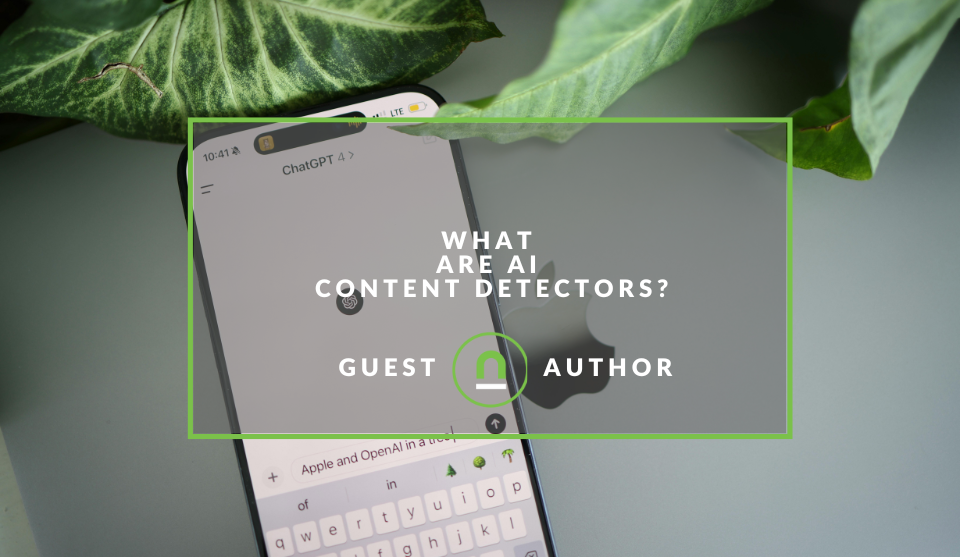Recent posts

Doctors Orders
The Difference Between SOAP Notes and DAP Notes
02 December 2025

Petrol heads
Why Load Bin Accessories Make Your Bakkie So Much Easier to Live With
26 November 2025

Alarming
What Is The Part Time Job WhatsApp Scam?
25 November 2025

Doctors Orders
How Data Has Changed The Healthcare Sector
24 November 2025
Popular posts
Extravaganza
Trending Music Hashtags To Get Your Posts Noticed
24 August 2018
Geek Chic
How To Fix iPhone/iPad Only Charging In Certain Positions
05 July 2020
Extravaganza
Trending Wedding Hashtags To Get Your Posts Noticed
18 September 2018
Money Talks
How To Find Coupons & Vouchers Online In South Africa
28 March 2019
What Are AI Content Detectors?
18 August 2024 | 0 comments | Posted by Olive Clinton in Geek Chic
Over the past two years, the digital landscape has witnessed an unprecedented surge in AI-generated content. The launch of Open-AI's large language model has put generative AI in front of the average person, and their app and other services in this space have exploded.
Big tech companies are all scrambling to find a way to expand LLMs, integrate them into products and monetise them more effectively in the future. Microsoft has gone all in with OpenAI and its GPT product. At the same time, Google has its service in Gemini, formerly known as BARD, and of course, Meta, wanting to be included in the party, has focused on its own LLM, Llama.
There is no shortage of access to LLMs for the average person, which big tech is willing to subsidise to train its models, and at this stage, this open access has reshaped industries, altered how we interact with information, and introduced both opportunities and risks.
But why has AI content become so prevalent? What are the reasons behind the widespread adoption of large language models (LLMs) for content creation, the potential for misuse, and the role of AI content detectors in addressing these challenges?
The Rise of AI-Generated Content
The past two years have witnessed an unprecedented surge in AI-generated content. This rapid growth can be attributed to several key factors:
- Advancements in Natural Language Processing (NLP): Significant breakthroughs in NLP have enabled AI models to understand, interpret, and generate human-like text with remarkable accuracy.
- Accessibility of Powerful Language Models: The democratisation of large language models (LLMs) through platforms like OpenAI has made it easier for individuals and businesses to harness their capabilities.
- Increased Computational Power: The availability of robust computing resources has facilitated the training and deployment of complex AI models. Economic Pressures: The demand for high-quality content coupled with rising production costs has driven many to explore AI as a cost-effective solution.
1. Technological Advancements
The explosion of AI-generated content is largely attributed to significant advancements in artificial intelligence, particularly in natural language processing (NLP).
Large Language Models (LLMs) such as OpenAI's GPT-3 and GPT-4, Google's Bard, and others have revolutionised content creation. These models are trained on vast datasets and can generate coherent, contextually relevant text across a variety of topics. Improvements in these models' capabilities, efficiency, and accessibility have driven their adoption.
2. Increased Accessibility
The democratisation of AI tools has made sophisticated technology available to a broader audience. Platforms that offer LLM services often provide user-friendly interfaces and flexible APIs, enabling individuals and businesses without deep technical expertise to leverage AI for content creation. This accessibility has contributed to the proliferation of AI-generated content across the web.
3. Cost Efficiency
AI-generated content offers a cost-effective solution for many organisations. Producing high-quality content traditionally requires substantial human effort and resources. By contrast, AI tools can generate articles, marketing materials, reports, and other forms of content quickly and at a fraction of the cost. This efficiency appeals to businesses looking to scale their content production without proportionally increasing their budget.
4. Personalisation and Adaptability
AI models excel at generating personalised content tailored to specific audiences. Businesses and content creators use AI to produce content that resonates with their target demographics, enhancing engagement and effectiveness. The ability to quickly adapt content based on feedback and changing trends further drives the adoption of AI tools.
The Adoption of LLMs for Content Creation
1. Versatility and Efficiency
LLMs can generate a wide range of content types, from blog posts and news articles to creative writing and technical documentation. Their versatility makes them invaluable for various applications, including marketing, education, and entertainment. The efficiency with which these models operate allows users to produce high volumes of content in a short period.
2. Enhanced Creativity and Inspiration
AI tools can serve as a source of inspiration, helping writers overcome creative blocks or generate ideas for new projects. By providing a starting point or offering alternative perspectives, LLMs can enhance human creativity and support content creators in producing novel and engaging material.
3. Consistency and Quality Control
Maintaining consistency in tone, style, and quality is a challenge in content creation, especially for large-scale projects. LLMs can help ensure that content adheres to predefined guidelines and maintains a consistent voice, which is particularly useful for brands with specific messaging requirements.
Potential for Misuse: Nefarious Applications of Generative Content
1. Disinformation and Fake News
One of the most concerning risks associated with AI-generated content is its potential use in spreading disinformation and fake news. LLMs can produce convincing yet false information that can mislead readers or manipulate public opinion. The ease with which such content can be generated and disseminated poses a significant challenge to information integrity.
2. Phishing and Scams
AI-generated content can be used to craft highly convincing phishing emails or scam messages. By mimicking legitimate communication styles, these messages can deceive individuals into divulging sensitive information or engaging in fraudulent activities. The sophistication of AI tools can make these threats more difficult to detect.
3. Deepfakes and Malicious Media
Generative AI is not limited to text; it also extends to creating deepfakes and other forms of synthetic media. These can be used to manipulate visual and auditory information, potentially leading to harmful consequences such as defamation, identity theft, and the spread of misleading content.
4. Academic Dishonesty
We were all students once, and if we found a way to cheat, we'd be tempted to do it, but gone are the days of copying the smart kid's homework; now you can get big tech to do your homework for you, and the quality is improving all the time.
Instead of just copying and pasting content from Wikipedia, today's students may use AI to generate essays and research papers without proper attribution.
The use of AI not only cheats on the assignment but defeats the purpose of the exercise, which is to engross yourself in a topic, learn about it, reason from first principles, and familiarise yourself with the concepts you will later use in the course or in your field of work.
5. Copyright Infringement
AI models trained on copyrighted material can inadvertently produce content that infringes on intellectual property rights, like branded characters or human likeness, through AI image generation tools.
The Role of AI Content Detectors
To reduce the misuse and abuse, along with the risks associated with AI-generated content, a new gatekeeper has been sprung up in the form of AI content detectors, which promise to sift out the humans from the bots.
These tools analyse text and identify patterns indicative of AI authorship, which are powered by, yes, you guessed it, generative AI models. Yes, the bots are fighting each other, like in the Terminator series.
AI detectors typically employ a combination of techniques:
- Statistical Analysis: They examine statistical properties of the text, such as word frequency, sentence structure, and readability scores, which often differ between human and AI-generated content.
- Machine Learning Models: These models are trained on large datasets of human and AI-generated text to learn to distinguish between the two.
- Pattern Recognition: Detectors look for specific patterns or stylistic quirks commonly found in AI-generated text.
1. Identifying AI-Generated Text
AI checkers are designed to identify and assess text generated by AI models. These tools analyse various linguistic features, patterns, and anomalies to distinguish between human-written and AI-generated content. By flagging suspicious content, detectors help prevent the spread of misinformation and ensure the credibility of information sources.
2. Combating disinformation
Content detectors play a crucial role in the fight against disinformation by identifying and addressing misleading or false content. They can be integrated into news platforms, social media, and other online environments to monitor and manage the quality of information being shared.
3. Supporting Ethical AI Use
By providing transparency and accountability, AI content detectors support the ethical use of AI technologies. They help organisations and individuals adhere to guidelines for responsible AI deployment and mitigate the risks associated with generative content.
4. Enhancing Content Authenticity
Detectors can also be used to verify the authenticity of content, ensuring that users can trust the information they encounter. This is particularly important in contexts such as academic publishing, journalism, and content marketing, where accuracy and integrity are paramount.
Generative content and its future gatekeepers
The explosion of AI-generated content over the past two years reflects significant advancements in technology, increased accessibility, and the growing demand for efficient content creation.
While LLMs offer numerous benefits, including versatility and cost efficiency, they also pose risks related to disinformation, phishing, and malicious media. AI content detectors play a vital role in addressing these challenges, helping to maintain the integrity of information and support ethical AI practices.
As the landscape continues to evolve, ongoing vigilance and the development of robust detection mechanisms will be essential in managing the impact of AI on content creation and consumption.
Tell us your story
Would you like to write for nichemarket just like Olive has? Find out how to submit a guest post and when you're ready, you can contact us.
Are you looking to promote your business?
Retail businesses can create their free business listing on nichemarket. The more information you provide about your business, the easier it will be for your customers to find you online.
Registering with nichemarket is easy; all you will need to do is head over to our sign-up form and follow the instructions. If you require a more detailed guide on how to create your profile or your listing, then we highly recommend you check out the following articles.
Recommended reading
If you enjoyed this post and have time to spare why not check out these related posts and dive deeper down the rabbit hole that is artificial intelligence.
- How to Integrate AI into the Customer Journey
- The Role of AI and Chatbots In Human Resources
- How To Prepare Your Career Path For Job Automation Disruption
- How AI Can Benefit Digital Marketing
- How Technology is Changing the World of Retail
Tags: AI, LLMs, Guest Post
You might also like
The Difference Between SOAP Notes and DAP Notes
02 December 2025
Posted by Che Kohler in Doctors Orders
A look at SOAP format, which remains the classic choice for healthcare professionals, while DAP notes offer more flexibility for mental health docume...
Read moreWhy Load Bin Accessories Make Your Bakkie So Much Easier to Live With
26 November 2025
Posted by Jasper J in Petrol heads
A look at how to get the most out of your bakkie, keep it protected as it works and why load bin accessories make your bakkie so much easier to live ...
Read more{{comment.sUserName}}
{{comment.iDayLastEdit}} day ago
{{comment.iDayLastEdit}} days ago
 {{blogcategory.sCategoryName}}
{{blogcategory.sCategoryName}}
